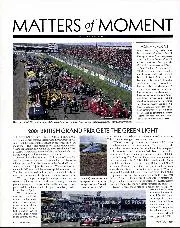
2001 British Grand Prix gets the green light
The British Racing Drivers' Club, owners of Silverstone, have retained next season's British Grand Prix despite speculation that the event might not happen following this year's traffic chaos. The World…
AS we write, the war-news is grave; may it have improved by the time these words are read. The fact remains that it is mechanised forces which have swept through Belgium and Holland, and are penetrating into France. During the next few weeks, British motor vehicles and motoring personnel will be engaged in the most vital fighting of the war.
After we have won the war, the lessons learned cannot fail to emphasise the importance of motor vehicles in modern warfare. We shall strive to maintain mechanised forces and to train skilled men to operate them. This military aspect of motoring must surely reflect favourably on post-war motor-racing and on motoring sport in general.
In any case, we are confident that motoring will regain lost ground, and become a primary factor in the life of the British people after the next Armistice. The motor-car is, to-day, a possession of social pride and vital interest in the eyes of educated peoples. That is true equally of the advanced type of fast car, the modern refined luxury carriage, and those cars which, by reason of outstanding engineering qualities, contrive to give excellent performance not-withstanding small engine size and compact form.
In other spheres, the motor-car is indispensable. The all-round sportsman gets a ton of pleasure from the use of a handy, open car of “sports” type, no matter how far removed we may consider his choice from the genuine thoroughbred. In the construction of special cars, and the tuning of production jobs is found a fascination akin to that enjoyed by the model maker, with the additional attraction of personal transport and personal participation in the operation of the completed vehicle, apart from the knowledge of full-scale engineering gained while working on it, which must constitute valuable experience capable of being turned to good effect in numerous civilian and war-time occupations.
Finally, the unlimited advantages of personal transport ensure the success of cars of all types, from the baby cars which are the hobby of the small family, to our individual quality cars which are both faithful servants and objects of pride to the great majority of our car-owning populace.
It may be that pessimists will foresee motoring seriously curtailed by rising taxation and prohibitive fuel costs after the war. In view of the motoring which is still going on under a 25/- per h.p. tax, coupled with a rationed annual mileage of much under 2,500, we are confident that when war-time restrictions are removed, motoring in all its forms cannot fail to flourish, even if increased costs make it necessary for lots of us to cut our former annual mileage of 10,000 or 20,000 down very appreciably to balance up.
With this widespread interest in motoring must come a greater appreciation of motoring sport throughout the land. Military requirements will encourage research; military training will develop a pride in good driving. Motor-racing must take on a new importance as a field of research and serve as it always has done as an unapproachable medium for advertisement and propaganda. Even while at war, Germany successfully raced B.M.W.s at Brescia. We have seen the output of this engine increased from about 55 b.h.p. to 80 b.h.p. by using inclined o.h. valves—a valve formation we have long advocated in this paper—and now pushed up to 130 b.h.p. Let such lessons come to the fore when we commence to race again, which we hope will be in the near future.